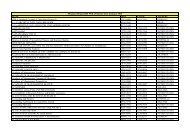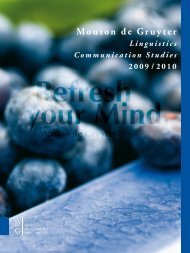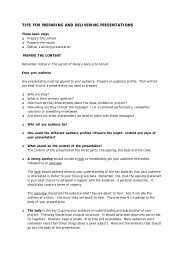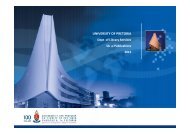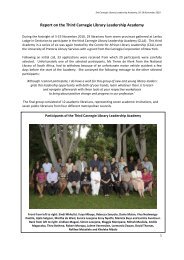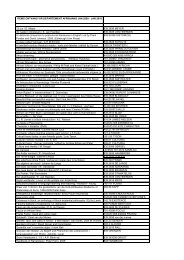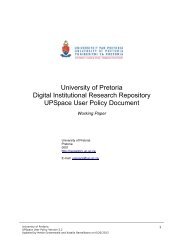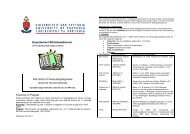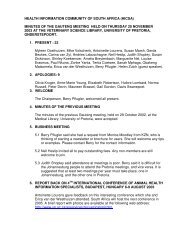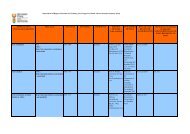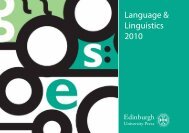Guidelines for Writing Technical Reports and Papers - Library
Guidelines for Writing Technical Reports and Papers - Library
Guidelines for Writing Technical Reports and Papers - Library
Create successful ePaper yourself
Turn your PDF publications into a flip-book with our unique Google optimized e-Paper software.
Copyright reserved<br />
University of Pretoria<br />
Department of Chemical<br />
Engineering<br />
<strong>Guidelines</strong> <strong>for</strong> <strong>Writing</strong><br />
<strong>Technical</strong> <strong>Reports</strong> <strong>and</strong> <strong>Papers</strong><br />
2006
Contents<br />
1 Introduction 3<br />
2 Format 3<br />
2.1 Font <strong>and</strong> spacing . . . . . . . . . . . . . . . . . . . . . . . . . . . . . . . 3<br />
2.2 Math . . . . . . . . . . . . . . . . . . . . . . . . . . . . . . . . . . . . . . 6<br />
2.3 Chemistry . . . . . . . . . . . . . . . . . . . . . . . . . . . . . . . . . . . 7<br />
2.4 Numbers <strong>and</strong> units . . . . . . . . . . . . . . . . . . . . . . . . . . . . . . 7<br />
2.5 Figures . . . . . . . . . . . . . . . . . . . . . . . . . . . . . . . . . . . . . 8<br />
2.6 Tables . . . . . . . . . . . . . . . . . . . . . . . . . . . . . . . . . . . . . 8<br />
2.7 Cross-referencing . . . . . . . . . . . . . . . . . . . . . . . . . . . . . . . 9<br />
2.8 Abbreviations . . . . . . . . . . . . . . . . . . . . . . . . . . . . . . . . . 9<br />
3 Structuring the Report/Paper 10<br />
3.1 Title . . . . . . . . . . . . . . . . . . . . . . . . . . . . . . . . . . . . . . 10<br />
3.2 Editorial in<strong>for</strong>mation . . . . . . . . . . . . . . . . . . . . . . . . . . . . . 10<br />
3.2.1 <strong>Reports</strong> . . . . . . . . . . . . . . . . . . . . . . . . . . . . . . . . 10<br />
3.2.2 <strong>Papers</strong> (Journal Articles) . . . . . . . . . . . . . . . . . . . . . . . 12<br />
3.3 Synopsis <strong>and</strong> keywords . . . . . . . . . . . . . . . . . . . . . . . . . . . . 13<br />
3.4 Introduction . . . . . . . . . . . . . . . . . . . . . . . . . . . . . . . . . . 14<br />
3.5 Theory or literature . . . . . . . . . . . . . . . . . . . . . . . . . . . . . . 14<br />
3.6 Experimental . . . . . . . . . . . . . . . . . . . . . . . . . . . . . . . . . 15<br />
3.6.1 <strong>Reports</strong> . . . . . . . . . . . . . . . . . . . . . . . . . . . . . . . . 15<br />
3.6.2 <strong>Papers</strong> . . . . . . . . . . . . . . . . . . . . . . . . . . . . . . . . . 15<br />
3.7 Results . . . . . . . . . . . . . . . . . . . . . . . . . . . . . . . . . . . . . 16<br />
3.8 Discussion . . . . . . . . . . . . . . . . . . . . . . . . . . . . . . . . . . . 16<br />
3.9 Conclusions (findings) . . . . . . . . . . . . . . . . . . . . . . . . . . . . 16<br />
3.10 Recommendations . . . . . . . . . . . . . . . . . . . . . . . . . . . . . . . 16<br />
3.11 References . . . . . . . . . . . . . . . . . . . . . . . . . . . . . . . . . . . 17<br />
3.11.1 General . . . . . . . . . . . . . . . . . . . . . . . . . . . . . . . . 17<br />
3.12 Appendices . . . . . . . . . . . . . . . . . . . . . . . . . . . . . . . . . . 18<br />
3.12.1 <strong>Reports</strong> . . . . . . . . . . . . . . . . . . . . . . . . . . . . . . . . 18<br />
3.12.2 <strong>Papers</strong> . . . . . . . . . . . . . . . . . . . . . . . . . . . . . . . . . 18<br />
4 <strong>Writing</strong> technical reports <strong>and</strong> papers 18<br />
4.1 Preparation . . . . . . . . . . . . . . . . . . . . . . . . . . . . . . . . . . 18<br />
4.1.1 Analyse the problem . . . . . . . . . . . . . . . . . . . . . . . . . 18<br />
4.1.2 Plan a comprehensive scheme . . . . . . . . . . . . . . . . . . . . 19<br />
4.2 <strong>Writing</strong> sequence . . . . . . . . . . . . . . . . . . . . . . . . . . . . . . . 19<br />
1
4.3 Editorial care . . . . . . . . . . . . . . . . . . . . . . . . . . . . . . . . . 19<br />
4.3.1 Sentence <strong>and</strong> paragraph construction . . . . . . . . . . . . . . . . 19<br />
4.3.2 Hierarchy of headings . . . . . . . . . . . . . . . . . . . . . . . . . 20<br />
5 Editing 20<br />
A Reference methods 22<br />
A.1 Policy of the Department of Chemical Engineering . . . . . . . . . . . . . 22<br />
A.1.1 References in the text . . . . . . . . . . . . . . . . . . . . . . . . 22<br />
A.1.2 A note on electronic documents . . . . . . . . . . . . . . . . . . . 23<br />
A.2 Examples . . . . . . . . . . . . . . . . . . . . . . . . . . . . . . . . . . . 24<br />
A.2.1 Important notes . . . . . . . . . . . . . . . . . . . . . . . . . . . . 25<br />
B Computer specific problems 26<br />
B.1 Graphic file <strong>for</strong>mats . . . . . . . . . . . . . . . . . . . . . . . . . . . . . . 26<br />
B.2 Equations . . . . . . . . . . . . . . . . . . . . . . . . . . . . . . . . . . . 28<br />
2
1 Introduction<br />
Most of the writing done by engineers consists of reports <strong>and</strong> papers. The purpose of these<br />
is to transfer in<strong>for</strong>mation to the reader. Different readers will have different requirements<br />
from a report or a paper. A managing director will probably not have time to read<br />
the report but will be interested in the most important results <strong>and</strong> recommendations.<br />
Somebody paging through a technical journal needs to establish quickly whether a paper<br />
is of importance to him/her. Once this has been determined, the reader may be interested<br />
in checking the in<strong>for</strong>mation in the finest detail: What was done How was it done What<br />
was it done with<br />
The most important problems experienced by technical writers are concerned with the<br />
structure (<strong>for</strong>mat) of their writing <strong>and</strong> with meeting the dem<strong>and</strong>s of accuracy, brevity<br />
<strong>and</strong> clarity.<br />
This guideline aims to prescribe a rigid structure <strong>for</strong> writing technical reports <strong>and</strong><br />
papers <strong>and</strong> to assist the writer by detailing the exact requirements of the different sections<br />
of a report/paper. The guidelines are <strong>for</strong>mal requirements of the Department of Chemical<br />
Engineering <strong>for</strong> all reports from practical training reports to PhD dissertations. For<br />
detailed in<strong>for</strong>mation about postgraduate studies, please refer to Buys (2003), which is<br />
available online from http://www.ais.up.ac.za/ebit/guides/research_guide.pdf.<br />
Note that the department’s style guidelines still apply.<br />
The writer should make use of good judgement to link the style <strong>and</strong> structure prescribed<br />
by this guide to areas not covered by the guide. This means that the written<br />
work should <strong>for</strong>m a cohesive whole even when not directly prescribed.<br />
2 Format<br />
<strong>Papers</strong> <strong>and</strong> reports typically consist of editorial in<strong>for</strong>mation, the introduction, the body<br />
of the report, (under headings such as theory, literature, experimental, results <strong>and</strong> discussion)<br />
conclusions, recommendations <strong>and</strong> a reference section. If necessary, <strong>and</strong> only if<br />
necessary, appendices are added.<br />
Typical basic outlines <strong>for</strong> reports <strong>and</strong> papers are shown in figures 1 <strong>and</strong> 2 respectively.<br />
For details of actual requirements, refer to chapter 3 of this guide.<br />
2.1 Font <strong>and</strong> spacing<br />
A font that is large enough to remain legible after being reduced in size (<strong>for</strong> instance,<br />
when printing two pages per page) should be used. A font size similar to Arial 12 or Times<br />
New Roman 14 is the minimum size that will be accepted. Garamond 14, CG Times 13<br />
<strong>and</strong> Courier New 12 are examples of acceptable fonts <strong>and</strong> sizes. Please compare the font<br />
3
Editorial In<strong>for</strong>mation<br />
Cover<br />
Title page<br />
Synopsis & keywords<br />
Acknowledgements<br />
Contents<br />
Nomenclature list<br />
1. INTRODUCTION<br />
2. LITERATURE (THEORY)<br />
3. EXPERIMENTAL<br />
3.1 Apparatus<br />
3.2 Planning (Experimental Design)<br />
3.3 Methods<br />
4. RESULTS (or RESULTS AND DISCUSSION)<br />
5. DISCUSSION<br />
6. CONCLUSIONS (or CONCLUSIONS AND RECOMMENDATIONS)<br />
7. RECOMMENDATIONS<br />
8. REFERENCES<br />
9. APPENDICES<br />
Figure 1: Format <strong>for</strong> reports – In a major report it is customary to start every section (Results,<br />
Recommendations etc) on a new page.<br />
4
Editorial In<strong>for</strong>mation<br />
Title<br />
Author<br />
Synopsis & keywords<br />
Nomenclature list<br />
1. INTRODUCTION<br />
2. THEORY (LITERATURE)<br />
3. EXPERIMENTAL<br />
4. RESULTS (or RESULTS AND DISCUSSION)<br />
5. DISCUSSION<br />
6. CONCLUSIONS (or CONCLUSIONS AND RECOMMENDATIONS)<br />
7. RECOMMENDATIONS<br />
8. ACKNOWLEDGEMENTS (if any)<br />
9. REFERENCES<br />
10. APPENDICES (not likely)<br />
Figure 2: Format <strong>for</strong> papers. In a paper every section is not necessarily started on a new page.<br />
Conserve space as much as possible.<br />
5
size of the type of font that you prefer to work in with these guidelines, keeping in mind<br />
that different fonts may appear differently sized even when they have the same point size<br />
selected in a word processor – refer to Appendix A1.3 of M<strong>and</strong>ersloot (2003), especially<br />
the table on page 184.<br />
As an example, consider the following two lines where fonts are compared with<br />
• the same “M” height M Arial M Times M Courier M Palatino<br />
• the same “x” height x Arial x Times x Courier x Palatino<br />
A line spacing of 1 1 (specified in the paragraph <strong>for</strong>mat section of the word processing<br />
2<br />
program) is prescribed with double that spacing between paragraphs.<br />
2.2 Math<br />
Mathematical symbols are treated as shown in the following example:<br />
The height h was measured as a function of time t. The relationship between<br />
h <strong>and</strong> t was found to be<br />
h(t) = h 0 − λt (1)<br />
It was also determined that the velocity v was a function of the position x<br />
given by f(v) = βx + sin(α) <strong>and</strong> that in general h max ≤ 5 m.<br />
Dynamic analysis showed that the system could be represented by<br />
⎡<br />
G(s) = 1 ⎣ 3 log b<br />
s + 1 2 1,1<br />
⎤<br />
⎦<br />
There<strong>for</strong>e, the model was revised to<br />
∂f<br />
∂t<br />
= 5t + g(t)<br />
dg<br />
dt = t + f(t)<br />
∫ b<br />
A = f(t)dt<br />
a<br />
A deeply nested equation:<br />
⎧ ⎡<br />
⎨<br />
( ) ⎤ ⎫<br />
s = sin<br />
⎩ arctan β<br />
⎣5 + √ ⎬<br />
x + cos<br />
1 + β + π ⎦<br />
⎭<br />
Notes:<br />
• Scalar variables (h, t, s) are italicised lower case.<br />
• Vector variables (v, x) are bold lower case, but not italicised.<br />
• Matrix variables (G) are upper case <strong>and</strong> italicised. Matrices are shown as above,<br />
with block brackets.<br />
6
• St<strong>and</strong>ard mathematical functions (sin(α), log b) <strong>and</strong> numeric constants are not italicised.<br />
• Numbered equations are centred, with the number in brackets on right margin.<br />
• A font similar to the body text font should be used, so when using a sans-serif font<br />
like Arial, the <strong>for</strong>mulae should be sans-serif as well.<br />
• Differential equations are stated using the correct partial derivative symbol ∂ (not<br />
a lowercase delta δ) or upright “d”s <strong>for</strong> partial or total derivatives.<br />
• Integrals are stated using upright “d”s<br />
• Deeply nested equations can use different brackets in the sequence {[()]}.<br />
2.3 Chemistry<br />
Use the IUPAC naming convention <strong>for</strong> compounds where possible unless there is a commonly<br />
used name (like acetone instead of dimethylketone). Favour using names in the<br />
text unless they are inordinately long, when the abbreviation can be used after initially<br />
stating the full name. Compound names should be cased normally (starting with upper<br />
case at the start of a sentence, <strong>and</strong> lowercase otherwise).<br />
More in<strong>for</strong>mation on naming conventions can be retrieved from the IUPAC website<br />
(http://www.iupac.org), where their automatic naming software (INChI) can also be<br />
downloaded.<br />
The correct symbols should be used <strong>for</strong> chemical reactions, particularly in reversible<br />
reactions like<br />
A + 2B ⇀↽ AB 2<br />
2.4 Numbers <strong>and</strong> units<br />
Numbers are shown with a decimal comma, spaces between thous<strong>and</strong>s <strong>and</strong> ×10 x notation<br />
rather than computer notation (1 023,2 × 10 −2 ).<br />
SI units should be favoured except where conversion would be uncom<strong>for</strong>table (refer<br />
to a 20 psi pressure limit rather than 137,895 1 kPa). Units should always be upright to<br />
differentiate them from variables (h = 1 m). Use st<strong>and</strong>ard SI prefixes instead of scientific<br />
notation unless a large variation in numbers occurs (use 1 nm instead of 1 × 10 −9 m).<br />
For more in<strong>for</strong>mation on the use of SI units see the NIST SI website at http://www.<br />
physics.nist.gov/cuu/Units<br />
7
2.5 Figures<br />
Figures are included in the text with no border, <strong>and</strong> a suitable caption is displayed below<br />
the figure as shown in figure 3.<br />
1<br />
0.5<br />
y<br />
0<br />
−0.5<br />
−1<br />
0<br />
sin(x)<br />
cos(x)<br />
1<br />
2 π π 3<br />
2 π 2π<br />
Figure 3: Example of a figure.<br />
x<br />
Use similar fonts (both size <strong>and</strong> lettertype) in the figure as in the main text <strong>and</strong><br />
always ensure that the caption explains the figure in more detail than “A plot of x vs y”<br />
– this is visible from the graph. Note the advice in appendix B.<br />
2.6 Tables<br />
Avoid vertical lines in tables as much as possible. The vertical lines of figures should be<br />
enough to guide the eye vertically. A slightly thicker line should be used at the top <strong>and</strong><br />
bottom of the table, with a thin line between the headings <strong>and</strong> the data.<br />
Table 1: Example of a table (adapted from Fear (2003))<br />
Item<br />
Animal Description Price b (R)<br />
Gnat a per gram 13,65<br />
each 0,01<br />
Gnu stuffed 92,50<br />
Emu stuffed 33,33<br />
Armadillo frozen 8,99<br />
a Norwegian blue gnats only<br />
b As of 2004<br />
Units should be specified in the heading of a column <strong>and</strong> longer descriptions included<br />
as footnotes below the table.<br />
8
2.7 Cross-referencing<br />
When referring to items in the same text, use normal casing <strong>and</strong> the correct number as<br />
in the following example:<br />
As can be seen from figures 1, 2 <strong>and</strong> 4, there is a strong correlation between<br />
heat transfer <strong>and</strong> Reynolds number. Equation 2 shows the proposed model,<br />
while equation 3 has an alternate <strong>for</strong>mulation proposed by Smee (1992). The<br />
experimental results are summarised in table 3. Section 4 discusses these<br />
results in more detail, while section 5 proposes novel research directions.<br />
Place figures <strong>and</strong> tables near to their first reference (but definitely after them). Each<br />
<strong>and</strong> every sketch, figure <strong>and</strong> table must be referred to in the text.r<br />
2.8 Abbreviations<br />
Our guidelines are adapted from Burger (1992, 17). All abbreviations are written without<br />
periods or spaces (New Testament → NT). Acronyms are written as spoken – capitals<br />
are used when the single letters are pronounced (CSIR), normal casing when they are<br />
pronounced as a word (Unisa). Try not to use abbreviations unless they are in common<br />
use. If an abbreviation is not likely to be understood by the audience, spell it out the<br />
first time <strong>and</strong> introduce the abbreviation in brackets: South African Institute of Chemical<br />
Engineers (SAIChE).<br />
9
3 Structuring the Report/Paper<br />
3.1 Title<br />
The title is a short, in<strong>for</strong>mative description of the investigation. It must be unambiguous<br />
<strong>and</strong> free of all unnecessary words, but must contain the important keywords describing<br />
the investigation.<br />
Many technical journals limit the title to 15 words.<br />
M<strong>and</strong>ersloot (2003) offers the following advice:<br />
• Avoid insignificant words <strong>and</strong> especially non-specific words like Investigation, Studies,<br />
Evaluating, Estimation, Method, Treatment, Assessment, Modelling, Application<br />
etc. In many instances the non-specific word can not be eliminated. In such<br />
cases do not start the title with these words – use them somewhere else in the title.<br />
• To maximise impact, start the title with the most significant issue – the Action<br />
or (more specific) the Subject of the action. For example: “Optimisation <strong>for</strong> the<br />
design of dividing wall columns” is of interest to those who are considering using<br />
such a column, there<strong>for</strong>e it calls <strong>for</strong> a title: “Dividing wall column optimisation”<br />
• Constrain the title to the main issues. For example “Adding value to SA raw<br />
materials – selective synthesis of thymol from m-cresol over zeolite catalysts” does<br />
not cover raw materials (plural) but one only. Mention this side issue in the text, but<br />
choose a title like “Selective m-cresol conversion to thymol over zeolite catalysts”<br />
or better “M-cresol to thymol; selective conversion over zeolite catalysts”.<br />
The semi-colon (or even the colon) is a very useful tool <strong>for</strong> turning titles around.<br />
3.2 Editorial in<strong>for</strong>mation<br />
3.2.1 <strong>Reports</strong><br />
The title of the report <strong>and</strong> the name(s) of the author(s) appear on the cover. This may<br />
be on specially textured paper or simply the outermost page of the report. Compare this<br />
to a published book. In the case of reports written <strong>for</strong> a specific university course (eg<br />
CPY 311, CLB 320) the course code is displayed at the bottom right h<strong>and</strong> corner of the<br />
cover. Laboratory reports <strong>and</strong> similar documents would normally not require a cover –<br />
the first page is then the title page.<br />
The first page is the title page on which the title <strong>and</strong> the author’s name again appear,<br />
as well as additional in<strong>for</strong>mation like the name of the institution, company or authority<br />
under whose name the report is published <strong>and</strong> the date. For university reports the<br />
student’s number <strong>and</strong> the course name <strong>and</strong> code will be given. In the case of <strong>for</strong>mal<br />
academic dissertations <strong>and</strong> <strong>for</strong> some laboratory reports, the university prescribes the<br />
10
Title of Report<br />
A Student<br />
Title of Report<br />
A Student<br />
20232329<br />
Synopsis<br />
Scope<br />
Main findings<br />
Main conclusions<br />
Keywords: a, b, c<br />
Sinopsis<br />
CXX323<br />
Contents<br />
Synopsis . . . . . . . . . . . . . i<br />
Nomenclature . . . . . . . ii<br />
1. Introduction . . . . . . 1<br />
Nomenclature<br />
b constant s<br />
v velocity km/h<br />
Greek<br />
ρ Density kg/m 3<br />
i<br />
1. Introduction<br />
Background<br />
Problem statement<br />
Purpose<br />
Method<br />
(see 3.4)<br />
2. Theory<br />
Summary of the state<br />
of the art, including<br />
ample references (see<br />
3.5)<br />
ii<br />
3. Experimental<br />
Aparatus<br />
Planning<br />
Methods<br />
(see 3.6)<br />
1<br />
4. Results<br />
Supporting evidence,<br />
most important results<br />
first. Use graphs <strong>and</strong><br />
tables where possible.<br />
(see 3.7)<br />
2<br />
5. Discussion<br />
Explain the observed<br />
correlations between<br />
variables (see 3.8)<br />
3<br />
6. Conclusions<br />
<strong>and</strong> Recommendations<br />
Main findings<br />
No new in<strong>for</strong>mation<br />
(see 3.9 <strong>and</strong> 3.10)<br />
4<br />
7. References<br />
Complete list of<br />
references in text. Not<br />
a reading list (see<br />
3.11)<br />
5<br />
6<br />
8<br />
Figure 4: Report <strong>for</strong>mat at a glance<br />
11
<strong>for</strong>mat of the title page. The in<strong>for</strong>mation is arranged intelligently to create a balanced<br />
impression. The cover <strong>and</strong> title page are not numbered.<br />
The synopsis appears on the very next page, to enable the cursory reader to find out<br />
immediately what the main findings <strong>and</strong> recommendations (if any) are. If a translated<br />
synopsis is given <strong>and</strong> both do not fit on one page, the translated synopsis must start on a<br />
new page. Keywords appear immediately after the synopsis. See section 3.3 <strong>for</strong> detailed<br />
requirements regarding a synopsis <strong>and</strong> keywords.<br />
If the author wishes to thank persons or other instances, this is done on the following<br />
page under the heading acknowledgement(s) Acknowledgements.<br />
The table of contents is given on the following page under the heading Contents. Each<br />
chapter or section is assigned a number <strong>and</strong> the number of the page on which the chapter<br />
starts is shown. The page on which the introduction starts is page number 1. Use a<br />
decimal numbering system <strong>for</strong> the headings of chapters, paragraphs <strong>and</strong> sub-paragraphs.<br />
Avoid subdivisions with more than four digits (eg 1.2.3.4.5). Such further divisions can<br />
be done in the text (but not shown in the table of contents) with an alphabetical notation.<br />
The table of contents does not include an item “Contents”.<br />
After the table of contents the nomenclature list is given (in alphabetical order) under<br />
the heading Nomenclature. All symbols used are defined <strong>and</strong> the units are given. Greek<br />
characters, subscripts <strong>and</strong> superscripts are tabulated separately. This list is generally<br />
only required if several equations are employed in the text. The nomenclature list does<br />
not include abbreviations, acronyms etc.<br />
The pages on which the editorial in<strong>for</strong>mation (synopsis, . . . nomenclature) appears are<br />
numbered with small roman numerals (i, ii, . . . ). These pages are also indicated in the<br />
table of contents. The headings (synopsis, contents, nomenclature etc) of the editorial<br />
in<strong>for</strong>mation are not numbered.<br />
3.2.2 <strong>Papers</strong> (Journal Articles)<br />
TITLE OF<br />
ARTICLE<br />
A Student, B Student †<br />
University of Pretoria<br />
SYNOPSIS<br />
Nomenclature<br />
1. Introduction<br />
5. References<br />
KEYWORDS: a, b, c<br />
2<br />
5<br />
Figure 5: Paper <strong>for</strong>mat at a glance<br />
12
A paper does not have a cover. The title page should contain the following:<br />
• The title in capitals, centred <strong>and</strong> not underlined.<br />
• Name/names of author(s), company affiliation(s) <strong>and</strong> address of the author to whom<br />
correspondence must be addressed.<br />
• A heading “SYNOPSIS” centred, followed by the synopsis of 100 to 200 words.<br />
• A heading “KEYWORDS:” at the left margin, followed (on the same line) by the<br />
keywords (generally no capitals).<br />
Nothing else appears on the title page. The in<strong>for</strong>mation on the title page is arranged<br />
to <strong>for</strong>m a balanced layout.<br />
The pages are numbered from the title page using ordinary (Arabic) numerals. The<br />
title page is usually not numbered, so the second page is number 2. If a nomenclature<br />
list is used, this appears at the top of page two, followed directly by the introduction. If<br />
the headings are numbered, number 1 is assigned to the Introduction.<br />
The remaining sections proceed as <strong>for</strong> a report. The theory section of an article is<br />
usually more brief than in a report, as the readership of the journal will typically be<br />
familiar with the subject matter.<br />
3.3 Synopsis <strong>and</strong> keywords<br />
The synopsis is complementary to the title <strong>and</strong> is read together with the title. All the<br />
elements which appear in the title need there<strong>for</strong>e not be repeated in the synopsis. The<br />
purpose of the synopsis is to summarise the<br />
• scope of the investigation,<br />
• main findings <strong>and</strong><br />
• main recommendations (if any).<br />
If the scope is not clear from the title, it can usually be defined with a one sentence<br />
objective statement. If the purpose of the investigation is not clear from the title <strong>and</strong> the<br />
main findings, this is also mentioned. The synopsis must, however, not contain phrases<br />
like “An investigation was launched . . . ”, “. . . is discussed” or “In this report/paper . . . is<br />
given/discussed/described . . . ”.<br />
Important numerical in<strong>for</strong>mation must be included in the synopsis. Use bullets to<br />
emphasise important points. Use paragraphs where appropriate.<br />
Keywords are used in in<strong>for</strong>mation retrieval systems. During a search of this nature papers<br />
with a certain keyword or combination of keywords are selected. Choose a maximum<br />
of five words to characterise the report, <strong>and</strong> choose them carefully.<br />
eg KEYWORDS: small, letters, same, line<br />
13
3.4 Introduction<br />
The purpose of the introduction is to put the reader in the position where the author was<br />
be<strong>for</strong>e he/she started the investigation.<br />
The following usually appear in the introduction<br />
• Background<br />
• Problem statement<br />
• Purpose of the investigation (objective statement)<br />
• Method (very, very brief), scope <strong>and</strong>/or limitations<br />
In principle, only enough background should be given to enable the reader to underst<strong>and</strong><br />
the problem statement. The problem should be stated in such a way that the<br />
objective can be understood. It is sometimes wise to combine the problem <strong>and</strong> objective<br />
statement if the objective is simply to solve the problem.<br />
In general, the problem statement outlines the justification <strong>for</strong> the investigation. For<br />
example: “The problem is a shortage of potassium <strong>for</strong> the manufacture of explosives; the<br />
purpose of the investigation was to determine the feasibility of a filtration technique to<br />
purify a locally available raw material containing potassium.”<br />
The method, scope <strong>and</strong> limitations are mentioned only. For that no more than a few<br />
sentences will be required. Further details can be given in the body of the report. For<br />
example: “The efficiency is determined experimentally in a laboratory scale investigation.<br />
Because of compressed air limitations, the investigation is limited to 300 kPa.” or “The<br />
number of swimming pools in the Pretoria municipal area was determined from aerial<br />
photographs. Indoor pools are, there<strong>for</strong>e, not included.” The limitation statement is<br />
not a list of excuses why some things were done badly or not at all. It is not a list of<br />
shortcomings in apparatus, etc.<br />
3.5 Theory or literature<br />
A chapter on literature is included if more comprehensive background is required than<br />
can conveniently be given in the introduction. This background will include in<strong>for</strong>mation<br />
of which the reader is probably not aware <strong>and</strong> which is required to underst<strong>and</strong> the report,<br />
to justify the investigation <strong>and</strong> to follow arguments <strong>and</strong> mathematical models or expositions.<br />
A review of relevant literature must be given in all project reports, laboratory<br />
investigations <strong>and</strong> dissertations.<br />
It is totally undesirable to rewrite major portions of eg a laboratory guide or textbooks,<br />
or to give detailed derivations of equations. Show only a summary of the current state of<br />
the art. Referencing must be used to indicate the source of each statement or data <strong>and</strong><br />
each equation or derivation used in the literature chapter.<br />
14
The literature section <strong>for</strong> a paper will of necessity be less comprehensive than <strong>for</strong> a<br />
full report. It should, however, always convince the reader that the investigation method<br />
<strong>and</strong> the experimental design were justified <strong>and</strong> that these were guided by the existing<br />
level of knowledge on the subject. The literature section should not be a survey of all<br />
the literature published on the topic. Only the relevant literature should be discussed.<br />
Never use the heading Literature “Survey” <strong>for</strong> this section.<br />
3.6 Experimental<br />
3.6.1 <strong>Reports</strong><br />
In reports the apparatus, planning <strong>and</strong> experimental methods are described in some<br />
detail. These can be included in one paragraph or each can be assigned a separate<br />
paragraph. The description <strong>and</strong>/or references must be complete enough to enable the<br />
in<strong>for</strong>med reader to repeat the experimental work.<br />
Apparatus Describe the apparatus used. Use sketches <strong>and</strong> give dimensions if necessary.<br />
Give equipment type <strong>and</strong> model number if very specialised equipment is used. Do not<br />
present the apparatus as a “shopping list”, use full sentences.<br />
Planning Name the independent variables <strong>and</strong> justify the choice. Justify the range of<br />
values investigated <strong>for</strong> the independent variables used. Show <strong>and</strong> justify the choice of<br />
dependent (or measured) variables. Show the experimental design. There are a number<br />
of good books on experimental design, among others one by Hicks (1982). Note that<br />
“experimental design” is not the design or choice of equipment or the experimental setup.<br />
It concerns the variables in the experiment, not the hardware.<br />
Methods Without using an idiot recipe style, describe the methods used in the experimental<br />
work <strong>and</strong> analysis. Use references freely; also references to st<strong>and</strong>ard methods <strong>and</strong><br />
techniques eg methods of chemical analysis.<br />
3.6.2 <strong>Papers</strong><br />
The experimental section in a paper is as brief as possible, but it must still be in<strong>for</strong>mative.<br />
In many cases the three sections (Apparatus, Planning <strong>and</strong> Methods) will be combined.<br />
Less detail will be given <strong>and</strong> referencing will be generous – but try not to reference the<br />
full report on which the paper is based.<br />
15
3.7 Results<br />
If it is immaterial to logic <strong>and</strong> flow of argument, report the most important results first.<br />
Use graphical <strong>and</strong> tabular presentation judiciously (see appendix <strong>for</strong> more detail). Do<br />
not, in the same report, show the same data graphically <strong>and</strong> in tabular <strong>for</strong>m. Indicate<br />
important points to the reader. It often makes more sense to report the results <strong>and</strong><br />
immediately discuss their significance. In such instances change the heading to “Results<br />
<strong>and</strong> discussion”. The discussion chapter will then automatically disappear.<br />
In reports, illustrate data manipulation using complete sample calculations. If it<br />
is feasible (<strong>for</strong> example in laboratory reports) sample calculations are placed here, but<br />
mostly these are placed separately in an appendix <strong>and</strong> referred to here. In the case<br />
of large projects, make meaningful subdivisions so that results do not disappear in the<br />
variety of data, calculations etc.<br />
Note: Generally it is a good idea to subdivide the results section. Sub-headings assist<br />
greatly in providing structure to a report or paper.<br />
In papers, data manipulation <strong>and</strong> sample calculations are not generally shown. It<br />
may at times be necessary to tell the reader (in principle) how the observed values were<br />
manipulated to arrive at the in<strong>for</strong>mation presented.<br />
3.8 Discussion<br />
The results of most technical projects are in the <strong>for</strong>m of correlations between different<br />
variables. The correlations must be explained using accepted theories <strong>and</strong> mechanisms.<br />
In the case of research projects new theories or mechanisms must be <strong>for</strong>mulated. From<br />
the viewpoint of the project leader’s evaluation, this is a very important chapter. It gives<br />
an indication of the author’s insight into the problem.<br />
3.9 Conclusions (findings)<br />
This chapter is a resumé of all the conclusions already drawn in the discussion chapter.<br />
There will consequently be some repetition. The most important conclusions must be<br />
mentioned first, unless this leads to bad logic or loss of argument. No new material,<br />
in<strong>for</strong>mation or conclusions may be introduced at this point.<br />
All the objectives of the investigation, as stated in the Introduction, must be addressed<br />
here. All conclusions mentioned here, must have been discussed be<strong>for</strong>eh<strong>and</strong>. All<br />
conclusions must be based on results.<br />
3.10 Recommendations<br />
Findings may lead to actions which should be considered. The recommended actions are<br />
summarised as recommendations. All recommendations must be justified or justifiable<br />
16
from the conclusions. Do not include the word recommendations in the heading if there<br />
are no recommendations to be made. If the scope of the recommendations does not justify<br />
it, the recommendations can be combined with the conclusions in one chapter.<br />
3.11 References<br />
References should not be confused with headings like “Bibliography” or “Further reading”,<br />
which frequently appear in non-technical reports. All references must be referred<br />
to in the text. <strong>Technical</strong> reports <strong>and</strong> papers do not contain headings like “Bibliography”.<br />
3.11.1 General<br />
With the exception of generally known facts, all statements that are not your own must<br />
be provided with a reference. Never create the impression that ideas, arguments, facts<br />
or conclusions are your own unless this is true. Plagiarism is a serious academic felony.<br />
Students are often unclear as to what constitutes plagiarism. A good rule of thumb is to<br />
reference everything that you did not create yourself, <strong>and</strong> any statements that you may<br />
have thought of yourself but may be controversial or counter-intuitive. At an underground<br />
level it is highly unlikely that a student will come up with something that has not been<br />
researched be<strong>for</strong>e. If you have not found supporting references, you have probably not<br />
looked hard enough. For more in<strong>for</strong>mation, browse the University’s plagiarism site at<br />
http://www.ais.up.ac.za/plagiarism.<br />
References are typically used to<br />
• justify statements <strong>and</strong> findings<br />
• enable the reader to consult the original source <strong>and</strong><br />
• acknowledge the author(s) <strong>for</strong> a specific contribution (Burger, 1992)<br />
The following statement need not be referenced: “ . . . at the conclusion of the Second<br />
World War in 1945 . . . ”<br />
Consult the original source as far as possible, since it will usually contain the most<br />
accurate account of the findings <strong>and</strong> limitations of a certain study. If, however, this is<br />
not possible (or if it is not available) the original source can be cited as follows:<br />
“Paul (quoted in Strathmann, 1988) found that . . . ”. Quotes from another person’s<br />
work must clearly be shown as such, with reference to the source. In our field of science<br />
direct quotations are seldom used; exceptions are possibly found in review articles or in<br />
articles with a qualitative or speculative tendency. When citing indirectly, only the direct<br />
source (the one you read) is included in the list of references.<br />
See Appendix A <strong>for</strong> a detailed discussion on reference methods.<br />
17
3.12 Appendices<br />
3.12.1 <strong>Reports</strong><br />
The previous chapters <strong>for</strong>m the core of the report. A good reporter will arrange them<br />
to <strong>for</strong>m a logical overview of the project. To achieve this it is usually necessary to<br />
exclude raw data, cumbersome calculations, supporting results (<strong>for</strong> example st<strong>and</strong>ardising<br />
of equipment) <strong>and</strong> documentary material (eg graphs used in calculations <strong>and</strong> computer<br />
programmes) from the main body of the report. Such material is then put in appendices<br />
as appropriate paragraphs <strong>and</strong> subparagraphs.<br />
Only one aspect is treated per appendix. Each appendix is provided with a number<br />
<strong>and</strong> descriptive heading <strong>and</strong> is indicated by page number in the table of contents. Every<br />
appendix must be mentioned in the text.<br />
Appendices should not contain unedited graphs, tables or figures. The symbols <strong>and</strong><br />
language used in the appendices must be the same as in the rest of the report. If computer<br />
programmed results are used in appendices these must preferably be in the same letter<br />
type as the rest of the report. Printouts of eg statistical data must be edited (or retyped)<br />
to eliminate unnecessary in<strong>for</strong>mation <strong>and</strong> undefined variables.<br />
It is important to provide the reader with in<strong>for</strong>mation about the items in the appendix<br />
– explain why they were included <strong>and</strong> clear up some of the more confusing aspects of the<br />
items. An appendix is not a place to “dump” in<strong>for</strong>mation of only peripheral interest to<br />
the reader.<br />
3.12.2 <strong>Papers</strong><br />
Only in exceptional cases will a paper contain an appendix. Such an appendix should<br />
preferably not be more than one page <strong>and</strong> will not necessarily start on a new page.<br />
4 <strong>Writing</strong> technical reports <strong>and</strong> papers<br />
4.1 Preparation<br />
Never simply start writing. Disciplined preparation is essential (Johnson, 1967).<br />
4.1.1 Analyse the problem<br />
Ask yourself certain questions <strong>and</strong> answer them as well as possible<br />
• Exactly what in<strong>for</strong>mation do I wish to convey in this report<br />
• What is the most logical order in which I can present this in<strong>for</strong>mation<br />
• For which group of readers am I writing<br />
18
• What background in<strong>for</strong>mation can I assume these readers already possess<br />
4.1.2 Plan a comprehensive scheme<br />
It will serve as your guide <strong>for</strong> writing<br />
Make as many subdivisions as possible<br />
Determine the hierarchy of headings. Bear in mind that in any scheme material will<br />
be separated into divisions <strong>and</strong> subdivisions which, by definition, will be equal to or<br />
subordinate to one another<br />
4.2 <strong>Writing</strong> sequence<br />
Although the title appears first <strong>and</strong> after that the synopsis, keywords, list of symbols,<br />
introduction etc, a report/paper is not written in this sequence.<br />
The Introduction is written first. Give the background, problem statement, purpose<br />
of the investigation <strong>and</strong> scope of the investigation (See section 3.4). After that the Main<br />
body of the report (See sections 3.5 to 3.8 <strong>and</strong> the Appendices (See section 3.12) are<br />
completed.<br />
The next important chapter is the Conclusions <strong>and</strong> recommendations. (See sections<br />
3.9 <strong>and</strong> 3.10). The conclusions are already justified in the main body of the report.<br />
Everything that is stated in the Introduction as an aim/purpose must be addressed in<br />
the conclusions. It is totally unacceptable to make unsubstantiated statements in this<br />
section. It is usually necessary to revise, refine or even rewrite the Introduction at this<br />
point.<br />
Now that the scope of the report is fixed <strong>and</strong> the conclusions are properly <strong>for</strong>mulated,<br />
the Synopsis is written. (See section 3.3)<br />
The very last job to be done is the <strong>for</strong>mulation of the Title. Write down a few titles<br />
<strong>and</strong> choose the best one (See section 3.1)<br />
4.3 Editorial care<br />
4.3.1 Sentence <strong>and</strong> paragraph construction<br />
The so-called fog index can be used to quantify the readability of a piece of prose. It<br />
is based on sentence length <strong>and</strong> the use of multi-syllable words. The longer the average<br />
length of the sentence, the less readable the report becomes. Try to keep the average<br />
sentence length under 15 to 20 words. Use simple explanatory sentences. Where long<br />
sentences are required, ensure that these are not confusing. Avoid vagueness, unnecessary<br />
words <strong>and</strong> words that do not say exactly what the author means.<br />
A paragraph consists of a number of sentences on a single topic or around a single<br />
theme. This theme is usually identified early on in the paragraph.<br />
19
4.3.2 Hierarchy of headings<br />
The chapters are the most important divisions <strong>and</strong> are numbered with single digits.<br />
Further divisions are done in decimal notation. Make sure that the numbering reflects<br />
the importance of the heading.<br />
If it is elected not to number chapter <strong>and</strong> paragraph headings, the hierarchy must be<br />
clear from the letter type (capital, bold, lower case, etc). Try not to underline headings.<br />
5 Editing<br />
The process used <strong>for</strong> editing is also used <strong>for</strong> marking of the student’s report or paper. It<br />
<strong>for</strong>ms the basis of the report editing checklist given in the study guides. This checklist<br />
is also used as a mark sheet in the Department. It is the responsibility of the author<br />
to scrutinise <strong>and</strong> grade his/her report in the same manner (or to have it done) be<strong>for</strong>e it<br />
is submitted to the main reader. A good author will wait a few days after writing the<br />
report be<strong>for</strong>e doing this exercise.<br />
Read the introduction first. Does it place the investigation in context, i.e. does it<br />
give background, problem statement, purpose/aim, limitations <strong>and</strong> scope of the investigation<br />
See section 3.4. Now read the conclusions. Do the conclusions link directly<br />
with the aims/purpose as set in the introduction Are the most important conclusions<br />
offered first Is there a reason why not Are the conclusions clear <strong>and</strong> unambiguous<br />
See section 3.9.<br />
The reader should now have a good idea of the success of the investigation. Page<br />
through the report <strong>and</strong> look at the headings. Is the hierarchy of headings correct, i.e.<br />
do the numbers or letter type indicate the importance of the heading Is it clear that all<br />
the important aspects are included See section 4.3.2.<br />
Now the report is read in its entirety, starting at the introduction. Note the content<br />
of each sentence <strong>and</strong> group of sentences (text analysis) to ensure that the text appears in<br />
the correct place in the report. (A trained editor will already have done Ax text analysis<br />
on the introduction <strong>and</strong> conclusions at the first reading).<br />
After text analysis one may find that :<br />
• there are results in the introduction<br />
• discussion is included in the part of the report that deals with experimental work<br />
• new experimental details are included in the discussion<br />
• discussion is included in the section that contains conclusions<br />
• some of the conclusions are not based on results<br />
20
• some of the recommendations do not flow from conclusions<br />
Also take care to include the following issues:<br />
Judge the author’s use of the theory <strong>and</strong> literature chapter(s). Is there a critical analysis<br />
of the relevant literature <strong>and</strong> theory Are the criteria used during the investigation<br />
properly identified Has a decent experimental design been done See section 3.6.<br />
Are results properly arrived at <strong>and</strong> presented Are graphical presentations used efficiently<br />
Note the significance of data <strong>and</strong> the correctness of sample calculations. See<br />
section 3.7. Gauge the author’s insight from the discussion, the interpretation of the results<br />
<strong>and</strong> significance of relationships <strong>and</strong> correlations. Is evaluation done using criteria<br />
that are identified in the literature Are valid conclusions drawn Has new material been<br />
introduced in the conclusions<br />
The reader should now be well acquainted with the investigation <strong>and</strong> can analyse the<br />
synopsis <strong>and</strong> the title. Are the main findings, main recommendations <strong>and</strong> (if necessary)<br />
the purpose <strong>and</strong> scope of the investigation clear from the synopsis Do the title <strong>and</strong><br />
synopsis <strong>for</strong>m a unit Is the title short <strong>and</strong> in<strong>for</strong>mative See sections 3.1 <strong>and</strong> 3.3.<br />
Is the report prepared with the necessary editorial care Note neatness, balanced<br />
page layout, care of language, spelling errors, integrity with respect to numbering, grammatical<br />
parallelism of headings <strong>and</strong> lists, sentence <strong>and</strong> paragraph construction, reference<br />
technique <strong>and</strong> the correct application of conventions with regard to figure <strong>and</strong> table titles.<br />
A trained editor will have noticed most of these errors during the first reading of<br />
the report.<br />
Does the report serve its purpose Is the report accurate, brief <strong>and</strong> clear Is the<br />
development logical Is the style acceptable<br />
It is strongly recommended that the report be read by a friend or colleague <strong>for</strong> a final<br />
check on spelling errors <strong>and</strong> readability.<br />
References<br />
Burger, M (1992) Reference Techniques. University of South Africa.<br />
Buys, A (2003) Research guide <strong>for</strong> postgraduate students. University of Pretoria.<br />
Fear, S (2003) “Publication quality tables in latex.”<br />
Hicks, CR (1982) Fundamental Concepts in the Design of Experiments. Holt Saunders,<br />
New York, 3rd ed.<br />
Johnson, TP (1967) “Fast functional writing: Organizae the report <strong>for</strong> wast writing, easy<br />
reading.” Chemical Engineer, 6, 30.<br />
M<strong>and</strong>ersloot, W (2003) “Scitech communication.” Chemical Technology, p. 33.<br />
21
Organisation, IS (1987) “Documentation biographic references content <strong>for</strong>m <strong>and</strong> structure.”<br />
Tech. rep., ISO, Genéve.<br />
A<br />
Reference methods<br />
Two very popular reference methods are the Harvard method <strong>and</strong> the augmented Harvard<br />
method. <strong>Guidelines</strong> <strong>for</strong> the use of these methods are contained in the International<br />
St<strong>and</strong>ards Organisation (ISO) guideline ISO 690 (Organisation, 1987). Burger (1992)<br />
discusses these methods from the perspective of a South African user.<br />
In brief, the Harvard method quotes an author in the text by means of a surname<br />
<strong>and</strong> the year of the publication, eg “. . . was found. (Smith, 1975)”. The references are<br />
then given in alphabetical order (according to the surname of the primary author) in<br />
the reference list. In the augmented Harvard method the text will contain a digit which<br />
coincides with the position of the source in the reference list, e.g. “. . . was found. [21]”.<br />
The references are then given in numerical order in the list of references. Although the<br />
augmented Harvard method is mostly used in scientific publications, we will, <strong>for</strong> practical<br />
reasons, use the ordinary Harvard method in this department.<br />
In practice a researcher/author will decide in which journal he/she wishes to publish<br />
<strong>and</strong> will then adopt the reference style of that journal. Usually instructions/guidelines<br />
<strong>for</strong> authors appear at the back of a journal, sometimes only in the December or January<br />
issue of the journal. Nevertheless, it is recommended that you scan the journal <strong>for</strong> a<br />
paper with a decent list of references <strong>and</strong> use it as your model.<br />
A.1 Policy of the Department of Chemical Engineering<br />
A.1.1<br />
References in the text<br />
In the general case the following are placed in brackets at the point of referencing in the<br />
text.<br />
Books<br />
(Smith, 1988: 45)<br />
Author’s surname + comma + date of publication + colon + page number e.g.<br />
Journals Author’s surname + comma + date of publication e.g. (Smith, 1988).<br />
Include initials if reference is made to more than one Smith e.g. (Smith, RP, 1988).<br />
Special cases:<br />
• If the date of publication is not known, use the copyright year or (if this not known):<br />
sa [= sine anno, no year], e.g. (Smith, sa)<br />
22
• The page number is typically shown when reference is made to a certain place in<br />
the book <strong>and</strong> not when the whole book, an extract from a book or a journal article<br />
is referred to.<br />
• Two authors are linked with “&” (Smith & Klein, 1988).<br />
• Three authors – first citation (Smith, Klein & Long, 1988) <strong>and</strong> at later citings<br />
(Smith et al, 1988); note the full stop <strong>and</strong> the comma <strong>and</strong> that “et al” is short <strong>for</strong><br />
et alii, <strong>and</strong> other.<br />
• More than three authors are treated in the same way as later citations of three<br />
authors, e.g. (Smith et al., 1988).<br />
• When the author is already mentioned in the text, the author’s name is not repeated,<br />
e.g. “Smith (1988) found that . . . ”<br />
• More than one reference <strong>for</strong> the same statement: (Smith & Klein, 1988; Peters,<br />
1989) or “Both Smith & Klein (1988) <strong>and</strong> Peters (1989) found that . . . ”.<br />
• Institutions must be referred to with minimum identification (Department of Energy<br />
Affairs, 1978) or (CSIR, 1987: 34).<br />
• If the same author published more than one publication in the same year, the<br />
publications are taken up in alphabetical order <strong>and</strong> marked “a, b, c, etc.”, e.g.<br />
(Smith, 1988a; Smith, 1988b).<br />
• Secondary references, e.g. when the original reference is not available, are treated<br />
as follows: (Smith, quoted by Peters, 1989: 45).<br />
• Unusual author surnames: (Van der Merwe & Day-Lewis, 1990).<br />
• In<strong>for</strong>mation taken from an encyclopedia is treated in the same way as a chapter or<br />
section in an edited book. The encyclopedia article usually has an author who is<br />
cited in the text. An example of a reference entry <strong>for</strong> this case is given under (b)<br />
below.<br />
A.1.2<br />
A note on electronic documents<br />
With the common use of electronic resources <strong>and</strong> the Internet, it is becoming more difficult<br />
to give a single reference <strong>for</strong> a physical article. There are several st<strong>and</strong>ards underway<br />
to provide a consistent way of referring to online sources, but the URL (something like<br />
http://www.someaddress.com) is not the preferred method, as it is not stable, i.e. the<br />
same in<strong>for</strong>mation will not be reliably available from the same URL <strong>for</strong> any length of time.<br />
For this reason, online sources should be quoted only after exhaustive search <strong>for</strong> a physical<br />
23
eference has yielded no results. There are very few web sites that exist totally removed<br />
from any physical media – if you are referencing a web site <strong>for</strong> important in<strong>for</strong>mation,<br />
there is a good chance they have referenced their sources <strong>and</strong> you would do well to consult<br />
the original material.<br />
If there is no way to avoid citing a web reference, ensure that you quote the data on<br />
which you visited the URL.<br />
A.2 Examples<br />
The cited references appear alphabetically in the reference list according to the name of<br />
the first author. Publications of the same author are arranged chronologically <strong>and</strong> when<br />
author <strong>and</strong> year are the same the sources are quoted alphabetically according to titles<br />
<strong>and</strong> distinguished by alphabetical letters (e.g. 1988a, 1988b).<br />
All the authors are mentioned. (et al. is never used in the reference list).<br />
Details of the publications are given in the following sequence: author, year of publication<br />
<strong>and</strong> title; after that it depends on whether the publication is a book, a journal or<br />
other work. Most of the options are indicated here as examples.<br />
Book<br />
• Kesting, RE (1972) Synthetic Polymeric Membranes, McGraw-Hill, New York.<br />
Paper published in a journal<br />
• Strathmann, H (1981) “Membrane separation processes” J. Membr. Sci., 9 (2), 121<br />
– 189.<br />
Patent<br />
• Henis, JMS <strong>and</strong> Tripodi, MK (1980a) “Multicomponent membranes <strong>for</strong> gas separation”,<br />
US Patent 4,230,463, assigned to Monsanto Corporation, US.<br />
• Henis, JMS <strong>and</strong> Tripodi, M K (1980b) “New method of producing defect- free<br />
membranes”, US Patent 4,230,454, assigned to Monsanto Corporation, US.<br />
Report, thesis or similar<br />
• Janzen, PA (1993) “Clean water supply to rural communities”, Zirkon Consultants’<br />
report to the Water Research Commission, Pretoria.<br />
• Van’t Hof, J (1988) Wet Spinning of Asymmetric Hollow Fibre Membranes <strong>for</strong> Gas<br />
Separation, PhD Thesis, University of Twente, Enschede, The Netherl<strong>and</strong>s.<br />
24
• O’Kelly, C (2001) Nanofiltration Membranes, Project Report, Dept Chem Eng,<br />
University of Pretoria.<br />
Encyclopaedia or similar<br />
• Gmehling, J <strong>and</strong> Onken, U (1977 – 1980) “Vapor-liquid equilibrium data collection”,<br />
Part 1 in Chemistry Data, Parts 1–7, D. Behrens <strong>and</strong> R. Eckermann (Eds.),<br />
Dechema, Frankfurt a.M.<br />
• Peters, S (1991) “Water soluble polymers”, in Ullmann’s Encyclopedia of Industrial<br />
Chemistry, A29, Wolff, R (Editor-in-Chief), VCR Vertrieb Publishers, Düsseldorf.<br />
• Smolders, CA (1980) “Morphology of skinned membranes: a rationale from phase<br />
separation phenomena”, in Ultrafiltration <strong>and</strong> Applications, I Cooper (Ed.), Plenum<br />
Press, New York.<br />
Reference in another publication<br />
• Smith, SA quoted by Billiton, RS (1995) . . . followed by book, or journal reference.<br />
Personal communication<br />
• Koros, WJ (1992) “Glass transition properties of glassy polymers”, Personal Communication,<br />
Department of Chemical Engineering, The University of Texas at<br />
Austin.<br />
Paper presented at a conference<br />
• Mazur, WH <strong>and</strong> Jakabhazy, SZ (1991) “Gas Separation Membranes – Now <strong>and</strong><br />
Tomorrow”, paper presented at The Europe-Japan Congress on Membranes <strong>and</strong><br />
Membrane Processes, 23 – 25 May, 1991, Stresa, Italy.<br />
Web page<br />
• Pritzker, TJ (1999) “An early fragment from Nepal”, http://www.ingress.com<br />
[2000, June 8]. The date in the square brackets is the access date.<br />
A.2.1<br />
Important notes<br />
• The references are not numbered. Paragraph spacing is used between references.<br />
• Volume numbers of journal articles are given in italics <strong>and</strong> the number of the issue<br />
(not in italics) follows in brackets. Some journals indicate the issue or volume as a<br />
month <strong>and</strong> then the same rules apply.<br />
25
• In the titles of journal articles or extracts from books, only the first word is capitalised.<br />
In the titles of books or conferences all the key words in the title are<br />
capitalised, e.g. Fundamentals of Heat <strong>and</strong> Mass Transfer.<br />
• The patents of Henis & Tripodi above are arranged alphabetically according to<br />
title. If the second author had been different, the patents would have been arranged<br />
according to the second author.<br />
• In the reference list “<strong>and</strong>” is used with more than one author, while the “&” is used<br />
in the text reference.<br />
• Each of an author’s initials is separated from the surname by a comma <strong>and</strong> followed<br />
by a full stop.<br />
• In the reference list it is common to give the first <strong>and</strong> last page numbers of a journal<br />
paper.<br />
• In the reference list the paper numbers of a book are not mentioned – they have<br />
already been given in the reference in the text.<br />
• When reference is made to a conference the year is shown between brackets after<br />
the author <strong>and</strong> often repeated when the conference dates are given.<br />
It must again be emphasized that these guidelines hold <strong>for</strong> this Department <strong>and</strong> that<br />
a number of alternative referencing systems are in use. A practical advantage of the<br />
Harvard method is that the elimination <strong>and</strong> addition of references is done without it<br />
being necessary to renumber all the references. It is also often easier <strong>for</strong> the reader if<br />
the referenced author is mentioned by name in the text, instead of being identified as a<br />
number only.<br />
B<br />
Computer specific problems<br />
B.1 Graphic file <strong>for</strong>mats<br />
When graphics are stored on a computer, there are two different approaches that can be<br />
taken. We can store in<strong>for</strong>mation about<br />
• each pixel (picture element) in the image or<br />
• the objects that make up the image (lines, arcs, blocks, etc).<br />
An image described using the pixel approach is termed a raster graphic, while images<br />
described using the second approach are called vector graphics.<br />
26
Raster<br />
Vector<br />
Figure 6: Difference between raster <strong>and</strong> vector graphics<br />
The difference between raster <strong>and</strong> vector graphics can easily be seen when enlarging<br />
or zooming in on an image as shown in figure 6.<br />
Most of the graphics in an engineering report will be well represented using vector<br />
graphics. They work well <strong>for</strong> plots, graphs <strong>and</strong> line drawings of equipment. They result in<br />
small file sizes <strong>and</strong> produce high quality output when printed. Examples of file extensions<br />
<strong>for</strong> vector files are EPS, WMF, EMF <strong>and</strong> Visio files. Raster grapihcs will probably be<br />
used exclusively <strong>for</strong> photographs or screen captures of computer software. Examples of<br />
file extensions <strong>for</strong> raster files are BMP, PNG, GIF, TIFF, <strong>and</strong> JPG.<br />
When preparing screen captures, another important aspect of graphic file <strong>for</strong>mat is<br />
the type of compression used. Most common raster file <strong>for</strong>mats are lossless, retaining all<br />
of the in<strong>for</strong>mation in the original file. The JPG file <strong>for</strong>mat, however, was designed to<br />
compress photographs <strong>and</strong> uses lossy compression based on mathematical reduction of<br />
the in<strong>for</strong>mation in the original file. The effect of this compression can be seen in figure 7,<br />
where a screenshot was taken <strong>and</strong> saved as a PNG file <strong>and</strong> a JPG file.<br />
The routines used to compress the image in JPG are optimised <strong>for</strong> photographs <strong>and</strong><br />
should only be used <strong>for</strong> images with “natural” characteristics, rather than computer<br />
generated images.<br />
Most students will incorporate graphics into a word-processor using “copy <strong>and</strong> paste”.<br />
This may cause the <strong>for</strong>mat of the file to be unknown. It is recommended that all graphics<br />
be saved as seperate files <strong>and</strong> then inserted into the document. This will not only ensure<br />
that the document retains a managable size, but make it easier to exchange graphics as<br />
well.<br />
27
Figure 7: Lossless compression (PNG) vs lossy compression (JPG). Note the noise or “artifacts”<br />
in the second image<br />
B.2 Equations<br />
A h<strong>and</strong>y way to get an equation like equation 2<br />
e = mc 2 (2)<br />
is to set up a style in your word processor containing a centre tab (⊥ on the toolbar) in<br />
the centre <strong>and</strong> a right tab (⌋ on the toolbar).<br />
I need advice from Word users on correct ways of including figures, tables,<br />
references <strong>and</strong> cross-references<br />
28



